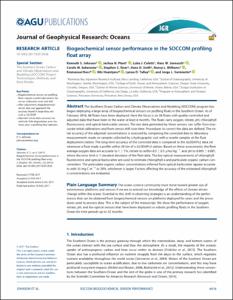| dc.contributor.author | Johnson, Kenneth S. | |
| dc.contributor.author | Plant, Joshua N. | |
| dc.contributor.author | Coletti, Luke J. | |
| dc.contributor.author | Jannasch, Hans W. | |
| dc.contributor.author | Sakamoto, Carole M. | |
| dc.contributor.author | Riser, Stephen C. | |
| dc.contributor.author | Swift, Dana D. | |
| dc.contributor.author | Williams, Nancy L. | |
| dc.contributor.author | Boss, Emmanuel | |
| dc.contributor.author | Haentjens, Nils | |
| dc.contributor.author | Talley, Lynne D. | |
| dc.contributor.author | Sarmiento, Jorge L. | |
| dc.coverage.spatial | Southern Ocean | en_US |
| dc.coverage.spatial | Antarctic Ocean | en_US |
| dc.date.accessioned | 2021-10-28T19:06:08Z | |
| dc.date.available | 2021-10-28T19:06:08Z | |
| dc.date.issued | 2017 | |
| dc.identifier.citation | Johnson, K. S., et al. (2017) Biogeochemical sensor performance in
the SOCCOM profiling float array. Journal of Geophysical Research, Oceans, 122, pp.6416–6436, DOI:10.1002/2017JC012838. | en_US |
| dc.identifier.uri | https://repository.oceanbestpractices.org/handle/11329/1764 | |
| dc.description.abstract | The Southern Ocean Carbon and Climate Observations and Modeling (SOCCOM) program has
begun deploying a large array of biogeochemical sensors on profiling floats in the Southern Ocean. As of
February 2016, 86 floats have been deployed. Here the focus is on 56 floats with quality-controlled and
adjusted data that have been in the water at least 6 months. The floats carry oxygen, nitrate, pH, chlorophyll
fluorescence, and optical backscatter sensors. The raw data generated by these sensors can suffer from inaccurate
initial calibrations and from sensor drift over time. Procedures to correct the data are defined. The initial
accuracy of the adjusted concentrations is assessed by comparing the corrected data to laboratory
measurements made on samples collected by a hydrographic cast with a rosette sampler at the float
deployment station. The long-term accuracy of the corrected data is compared to the GLODAPv2 data set
whenever a float made a profile within 20 km of a GLODAPv2 station. Based on these assessments, the fleet
average oxygen data are accurate to 161%, nitrate to within 0.560.5 mmol kg21, and pH to 0.00560.007,
where the error limit is 1 standard deviation of the fleet data. The bio-optical measurements of chlorophyll
fluorescence and optical backscatter are used to estimate chlorophyll a and particulate organic carbon concentration.
The particulate organic carbon concentrations inferred from optical backscatter appear accurate
to with 35 mg C m23 or 20%, whichever is larger. Factors affecting the accuracy of the estimated chlorophyll
a concentrations are evaluated. | en_US |
| dc.language.iso | en | en_US |
| dc.rights | Attribution-NonCommercial-NoDerivatives 4.0 International | * |
| dc.rights.uri | http://creativecommons.org/licenses/by-nc-nd/4.0/ | * |
| dc.subject.other | Oxygen sensor | en_US |
| dc.subject.other | Nitrate sensor | en_US |
| dc.subject.other | Bio-optical sensor | en_US |
| dc.subject.other | Profiling floats | en_US |
| dc.subject.other | SOCCOM | en_US |
| dc.title | Biogeochemical sensor performance in the SOCCOM profiling float array. | en_US |
| dc.type | Journal Contribution | en_US |
| dc.format.pagerange | pp.6416-6436 | en_US |
| dc.identifier.doi | 10.1002/2017JC012838 | |
| dc.subject.parameterDiscipline | Chemical oceanography | en_US |
| dc.subject.instrumentType | pH sensors | en_US |
| dc.subject.dmProcesses | Data processing | en_US |
| dc.bibliographicCitation.title | Journal of Geophysical Research, Oceans | en_US |
| dc.bibliographicCitation.volume | 122 | en_US |
| dc.description.sdg | 14.a | en_US |
| dc.description.eov | N/A | en_US |
| dc.description.maturitylevel | Mature | |
| dc.description.adoption | Multi-organisational | en_US |
| dc.description.sensors | Biogeochemical sensors | en_US |
| dc.description.methodologyType | Method | en_US |
| dc.description.methodologyType | Specification of criteria | en_US |
| obps.contact.contactname | K. S. Johnson | |
| obps.contact.contactemail | johnson@mbari.org | |
| obps.resourceurl.publisher | https://agupubs.onlinelibrary.wiley.com/doi/10.1002/2017JC012838 | |
 Repository of community practices in Ocean Research, Applications and Data/Information Management
Repository of community practices in Ocean Research, Applications and Data/Information Management

